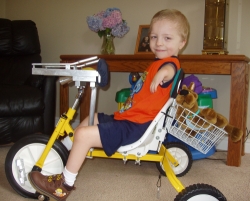Designers: Derek Juang and Irene Tseng
Client Coordinators: Barbara Howard
Supervising Professor: Dr. Larry N. Bohs
 Our client is a 5 year-old boy with TAR syndrome, which is characterized by the absence of radii bones in the forearms, leading to shortness in arm length. He has limited arm movement and rotation as well as minimal strength in his fingers. Both legs exhibit restricted bend (15 degrees bend in right leg, 90 degrees in left leg) and strength. The aim of this project was to modify his commercial tricycle to allow for independent use. The completed design includes a four-bar linkage for steering, telescoping arms to facilitate mounting and dismounting, and a weighted front wheel and unequal crank arm lengths to help compensate for leg differences.
Our client is a 5 year-old boy with TAR syndrome, which is characterized by the absence of radii bones in the forearms, leading to shortness in arm length. He has limited arm movement and rotation as well as minimal strength in his fingers. Both legs exhibit restricted bend (15 degrees bend in right leg, 90 degrees in left leg) and strength. The aim of this project was to modify his commercial tricycle to allow for independent use. The completed design includes a four-bar linkage for steering, telescoping arms to facilitate mounting and dismounting, and a weighted front wheel and unequal crank arm lengths to help compensate for leg differences.
How this project helped
Prior to design modification, the client was unable to use the tricycle. The client’s mother said, “It is incredible to see our son do something that other children, including his siblings, can do and up until this project he was unable to do. Most of the activities he does differently from other kids, and doing something the same way others do is really helping him to realize he can do anything he wants.” The client said, “I like my tricycle because they cut the handle bars off, and now I can ride it with (my brother and sister). I also like the basket, so I can put stuff in it, like flowers and rocks, and bring them home to my mommy.”
The steering system uses a four-bar linkage, which allows the client to steer the tricycle using his hands, which are near his shoulders. The four-bar linkage consists of four solid aluminum bars connected at four pivot points (Figure 2, left). Since the four-bar linkage steering system must stay parallel to the ground on which the tricycle is sitting, a universal joint translates parallel motion of the steering system into angled motion of the wheel (Figure 2, center). Pushing with the right shoulder causes the right side of the four-bar linkage to shift forward and the wheel to turn to the left. Similarly, pushing with the left shoulder causes the tricycle to turn to the right. This design capitalizes on the torso strength and flexibility of the client, and does not require using his limited arm and finger strength.
Telescoping handlebars make it easier for the client to mount and dismount the tricycle (Figure 2, right). A paddle bar locking mechanism secures the handlebars in place during tricycle use. The paddle bars attach to the top surface of the solid telescoping bars via a hinge and spring. Two pins on the other end of the paddle bars fit into a series of holes in the top surface of the hollow aluminum tube. To dismount the tricycle, the client applies a small force on the paddles to raise the pins and push the handlebars forward. To begin cycling, the client pulls the handlebars toward himself until the pins drop into a comfortable position.
Two modifications address the flexibility and strength limitations in the client’s right leg. To address the restricted range of motion for the right leg, the crank shaft of the right pedal was shortened, decreasing the range through which this foot moves on each pedal stroke. A weighted wheel, consisting of five large fishing weights, assists the power stroke of the right leg. These weights mount at roughly two o’clock when the right foot is beginning its downstroke.
The cost of parts for the project was approximately $130.